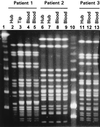Randomized, double-blind trial of an antibiotic-lock technique for prevention of gram-positive central venous catheter-related infection in neutropenic patients with cancer
- PMID: 10471564
- PMCID: PMC89446
- DOI: 10.1128/AAC.43.9.2200
Randomized, double-blind trial of an antibiotic-lock technique for prevention of gram-positive central venous catheter-related infection in neutropenic patients with cancer
Abstract
The aim of the present study was to determine the efficacy of an antibiotic-lock technique in preventing endoluminal catheter-related infection with gram-positive bacteria in neutropenic patients with hematologic malignancies. Patients with nontunneled, multilumen central venous catheters were assigned in a randomized, double-blinded manner to receive either 10 U of heparin per ml (57 patients) or 10 U of heparin per ml and 25 microg of vancomycin per ml (60 patients), which were instilled in the catheter lumen and which were allowed to dwell in the catheter lumen for 1 h every 2 days. Insertion-site and hub swabs were taken twice weekly. The primary and secondary end points of the trial were significant colonization of the catheter hub and catheter-related bacteremia, respectively. Significant colonization of the catheter hub occurred in nine (15.8%) patients receiving heparin (seven patients were colonized with Staphylococcus epidermidis, one patient was colonized with Staphylococcus capitis, and one patient was colonized with Corynebacterium sp.), whereas the catheter hubs of none of the patients receiving heparin and vancomycin were colonized (P = 0.001). Catheter-related bacteremia developed in four (7%) patients receiving heparin (three patients had S. epidermidis bacteremia and one patient had S. capitis bacteremia), whereas none of the patients in the heparin and vancomycin group had catheter-related bacteremia (P = 0.05). The times to catheter hub colonization and to catheter-related bacteremia by the Kaplan-Meier method were longer in patients receiving heparin and vancomycin than in patients receiving heparin alone (P = 0.004 and P = 0.06, respectively). Our study shows that a solution containing heparin and vancomycin administered by using an antibiotic-lock technique effectively prevents catheter hub colonization with gram-positive bacteria and subsequent bacteremia during chemotherapy-induced neutropenia in patients with hematologic malignancy.
Figures




References
-
- Benoit J L, Carandang G, Sitrin M, Arnow P M. Intraluminal antibiotic treatment of central venous catheter infections in patients receiving parenteral nutrition at home. Clin Infect Dis. 1995;21:1286–1288. - PubMed
-
- Capdevila J A, Gavalda J, Pahissa A. Antibiotic-lock technique: usefulness and controversies. Antimicrob Infect Dis News. 1996;15:9–13.
-
- Domínguez M A, Liñares J, Pulido A, Pérez J L, De Lencastre H. Molecular tracking of coagulase-negative staphylococcal isolates from catheter-related infections. Microb Drug Resist. 1996;2:423–429. - PubMed
-
- Eastridge B J, Lefor A T. Complications of indwelling venous access devices in cancer patients. J Clin Oncol. 1995;13:233–238. - PubMed
-
- González-Barca E, Fernández-Sevilla A, Carratalà J, Grañena A, Gudiol F. Prospective study of 288 episodes of bacteremia in neutropenic cancer patients in a single institution. Eur J Clin Microbiol Infect Dis. 1996;15:291–296. - PubMed
Publication types
MeSH terms
Substances
LinkOut - more resources
Full Text Sources
Other Literature Sources
Medical

